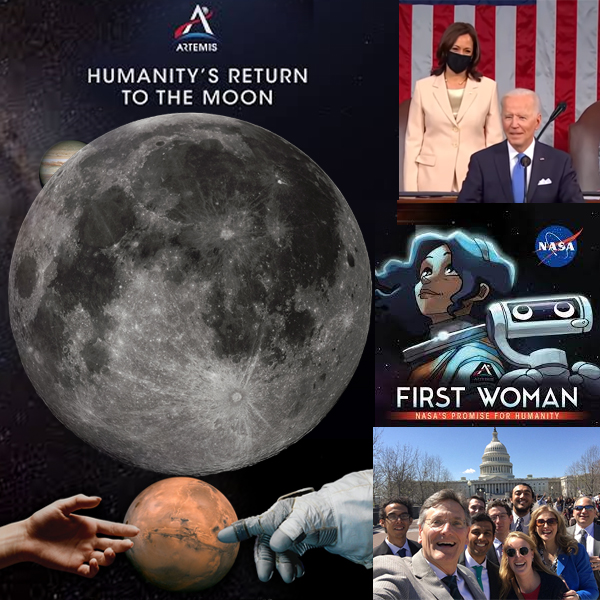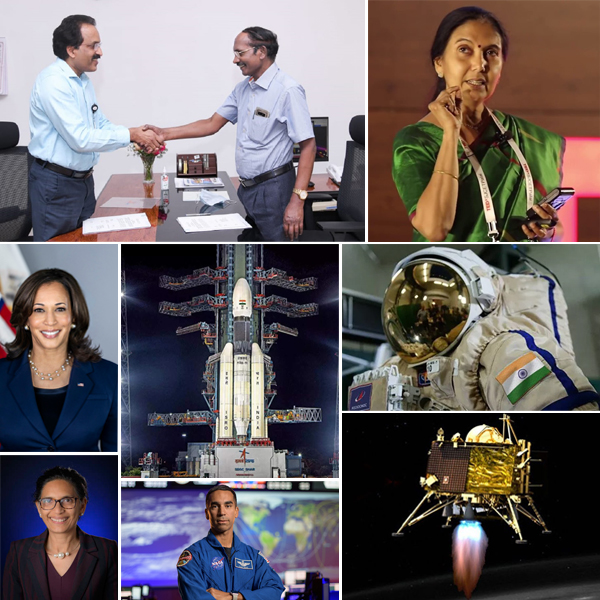USA Pathfinding 1st Women on the Moon, Mars and 21st Century Solar System Complete
|
MONDAY☆ Feb 28 – ISS, ~405-km LEO: Expedition 66 seven-member crew to work with cargo from Cygnus NG-17, Progress 80P; Shkaplerov, Dubrov, Vande Hei to remain aboard for 1 more month. ☆ Feb 28 – Tiangong Space Station, ~370-km LEO: Shenzhou 13 to be first to attempt rapid return to Earth in April; Long March 5B-Y3 to launch Wentian module soon shipping to Wenchang launch center. Highlights… o NewSpace: MDA subcontracting Rocket Lab to build 17 LEO satellite chassis for Globalstar under $143 million deal; Virgin Galactic on track for commercial spaceflight this year per CEO Michael Colglazier (after tallying $1B loss in last 2 years). ☆ Solar System: SwRI / PSI researchers argue tidal heating-produced liquid ocean under 24–31 km ice shell may account for Cassini measurement of Mimas libration; CAS scientists analyzing imagery of ≤4cm ‘translucent glass globules’ taken by Yutu-2 within Moon South-Pole Aitken basin. ☆ Galaxy: ESO Astronomers working to characterize Proxima d with VLT instrument ESPRESSO; Swedish team utilizing IR spectrometer determine supernova origin of ytterbium, allowing “mapping extensive parts of the Milky Way that have previously been unexplored” due to dust obstruction. o Global: USA & Russia space cooperation to continue despite political crisis in Ukraine, per U.S. State Department, NASA and Roscosmos Director Rogozin; France President Macron characterizes proposed $6.8B EU communications satellite constellation as “matter of sovereignty”; study continues on 1st known quadruple asteroid system discovered by NARIT Astronomer using ESO data. ● USA: State of Union Address this week could have major implications for USA future in space; NASA approves Multi-slit Solar Explorer (US$192M) and HelioSwarm ($250M) to study Solar environment / Sun-Earth connection; 6kg Nanosat Atmospheric Chemistry Hyperspectral Observation System (NACHOS) to be deployed from Cygnus NG-17, will monitor volcanic eruption predictor trace gasses SO2, NO2. ● Hawai’i: Maunakea Scholars program mentor and DOE Computational Science Graduate Fellow Michael Tucker utilizes University of Hawaii 2.2 meter Telescope instrument SuperNova Integral Field Spectrograph to discover transients. |
 |
● = Terrestrial events, and…
o = International terrestrial events in local time. ★ = Space events, and… ☆ = International space / astro events in Hawaii Standard Time unless noted. Add 10 hours to obtain UT (‘Universal Time’). |
Weekly Planet Watch – Evening Planets: Uranus (W); Morning Planets: Mercury (SE), Venus (SE), Mars (SE), Saturn (SE).
ISRO Works to Commercialize, Achieve Ambitious 2022 Launch Schedule While Engaging International Partnerships
|
● Feb 28 – NASA, Axiom, Online / Washington DC: News Conference: Axiom Mission 1 (Ax-1) briefing; features Kathy Lueders, Robyn Gatens, Phil McAllister, Michael Suffredini; starts 11:00 EST. o Feb 28 – Mar 4 – The Japan Society for Aeronautical and Space Sciences, International Academy of Astronautics, Beppu, Japan: 14th IAA Low-Cost Planetary Missions Conference; with 33rd International Symposium on Space Technology and Science, and 10th Nano-Satellite Symposium. ● Feb 28 – Mar 4 – Gemini Observatory, NSF, NOIRLab, Maunakea Observatories, Online / Hilo HI: 18th Journey Through the Universe. ☆ Feb 28 — Moon: 3.6° SE of Mercury, 13:00; with Mercury, and Saturn within circle of diameter 4.19°, 15:00; 4.1° SE of Saturn, 17:00. ☆ Feb 28 — Mercury: At aphelion, 0.4667 AU from Sun, 13:00. ☆ Feb 28 — Aten Asteroid 2020 UO4: Near-Earth Flyby (0.047 AU) Continued From… o Dec 20 – Mar 4 – JAXA, Online / Tokyo, Japan: Accepting applications for Japan Astronaut Candidates. o Feb 10 – Mar 9 – JAXA, Online: Astronaut Hoshide ISS Mission Report Virtual Expo; sharing never-before released video of the interior of the ISS and activities. o Feb 11 – Mar 8 – International Astronomical Union, Global: Women and Girls in Astronomy. ☆ NET Feb 27 – Rocket Lab, Synspective, Launch Electron / StriX-β, Launch Complex 1, Mahia Peninsula, New Zealand: 14-day launch window opens for Mission ‘The Owl’s Night Continues’ to add second synthetic aperture radar satellite to constellation of Tokyo-based Synspective. TUESDAY☆ Mar 1 — Deep Space, 41 LY from Earth: Scientists eager to study 7 planets of Trappist-1 system (particularly Trappist-1e) with James Webb Telescope for atmosphere / habitability data. ★ Mar 1 – United Launch Alliance, Launch Atlas 5 / GOES-T, SLC-41, Cape Canaveral SFS FL: Launch scheduled for GOES-T, third next-generation geostationary weather satellite for NASA and NOAA. |
● Mar 1 – USA Administration, Washington DC / Online: State of the Union Address 2022 to be given by 46th President Joe Biden; high priority may be on Artemis, First Woman and First Person of Color on the Moon, Earth Observation.
● Mar 1 – Explore Mars Inc., Washington DC / Online: Web Event: Astronaut Dr. Sian “Leo” Proctor; 20:00 EST.
● Mar 1-2 – NASA, Washington DC / Online: NASA Advisory Council Meeting; 13:00-17:00 EST.
☆ Mar 1 — Amor Asteroid 153591 (2001 SN263): Near-Earth Flyby (0.101 AU)
WEDNESDAY
● Mar 2 – NASA, Space Weather Council, Washington DC / Online: NASA Heliophysics Advisory Committee Meeting; 12:00-15:00 EST.
● Mar 2-3 – University of Texas at Austin Strauss Center, Cockrell School of Engineering, International Academy of Astronautics (IAA), Online / Austin TX: 8th annual Space Traffic Management conference: Anthropogenic Environmental Impact and Assessment of Space Traffic on Space Operations and Implications for Climate Change Monitoring.
☆ Mar 2 — Moon: New Moon, 07:37; 3.8° SE of Jupiter, 12:00.
☆ Mar 2 — Mercury: 0.67° SE of Saturn, 06:00.
THURSDAY
★ Mar 3 – SpaceX, Launch Falcon 9 / Starlink 4-9, SLC-39, Kennedy Space Center FL: SpaceX Falcon 9 rocket to launch next batch of Starlink satellites.
☆ Mar 3 — Moon: 3.4° SE of Neptune, 03:00.
FRIDAY
☆ Mar 4 – Long March 3C Rocket Booster to Impact Moon, Lunar Surface: Booster from Chang’e 5 T1 Mission likely to strike near Sea of Tranquility (5.18°N, 233.55°E) on Moon far side at 12:25:58 UTC.
☆ Mar 4 – Roscosmos, Launch Soyuz / OneWeb 14, Baikonur Cosmodrome, Kazakhstan: Next scheduled launch of 36 satellites into orbit for OneWeb.
● Mar 4 – University of Central Florida (UCF) India Center, Online: Launching Farther: A Discussion of India’s Space Policy; by Rajeswari Rajagopalanof Observer Research Foundation.
● Mar 4 – Explore Mars Inc., Washington DC / Online: ARTEMIS 1: Next Gen Tech for Our Next Adventure to the Moon; 13:00 EST.
● Mar 4 – NASA, NSF, DOE, Washington DC / Online: Astronomy and Astrophysics Advisory Committee Meeting.
● Mar 4-5 – Liftport Group, Online / Tacoma WA: Better Futures: Online Conference Series.
☆ Mar 4 — Apollo Asteroid 2021 UL7: Near-Earth Flyby (0.030 AU)
☆ Mar 4 — Apollo Asteroid 138971 (2001 CB21): More than 1-km wide asteroid Near-Earth Flyby (0.033 AU)
SATURDAY
☆ Mar 5 — Jupiter: At conjunction with Sun, 5.972 AU from Earth, 04:00.
SUNDAY
☆ Mar 6 — Moon: 0.85° SE of Uranus, 22:00.
☆ Mar 6 — Apollo Asteroid 2020 DC: Near-Earth Flyby (0.010 AU)

